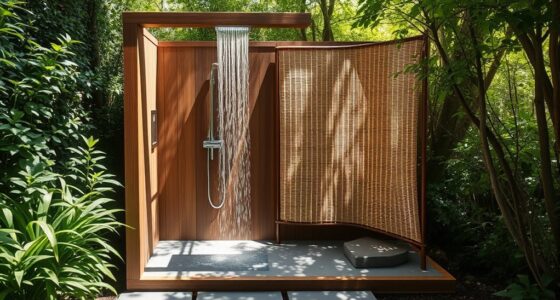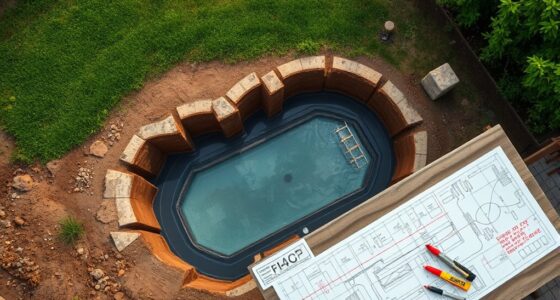Before installing a pool, you need to understand your local zoning laws. These rules specify where you can place your pool, how tall it can be, and how close it must stay to property lines. You’ll also need permits for building, electrical work, and fencing. Failing to follow these laws can cause delays or rework. Keep exploring to learn how to navigate these regulations smoothly and guarantee your project stays on track.
Key Takeaways
- Zoning laws dictate pool placement, setbacks, and height restrictions to ensure safety and neighborhood harmony.
- Obtaining permits confirms compliance with building codes, electrical, plumbing, and safety standards for your pool project.
- Setback and height regulations influence pool size, location, and design, preventing legal issues or delays.
- Local jurisdictions and HOA rules may impose additional restrictions on pool size, fencing, and safety features.
- Early planning and permit approval help avoid fines, project delays, or the need for costly modifications.
Understanding Local Zoning Regulations for Pools

Have you ever wondered what local zoning laws say about installing a pool in your backyard? Zoning regulations determine where you can place your pool, how close it can be to property lines, and whether you need special setbacks or height restrictions. These rules help guarantee safety, privacy, and neighborhood harmony. Before diving into your project, check with your local planning department or zoning office. They’ll provide details on lot size requirements, fencing rules, and any restrictions on pool size or use. Understanding the contrast ratio can help you better visualize how your pool will look once installed, especially in relation to surrounding structures. Ignoring these regulations can lead to fines or having to remove your pool later. Understanding the rules upfront saves you time, money, and frustration, ensuring your backyard oasis complies with all local ordinances.
Types of Permits Required for Pool Installation

Installing a pool typically requires obtaining several permits to guarantee your project complies with local safety and building codes. These permits ensure your pool is safe, legal, and up to code. Common permits include:
Getting the necessary permits ensures your pool project is safe, legal, and up to code.
- Building Permit – Allows construction based on structural plans and safety standards.
- Electrical Permit – Needed for wiring, lighting, and electrical equipment installation.
- Plumbing Permit – Covers plumbing connections, drainage, and filtration systems.
- Fence or Barrier Permit – Ensures safety barriers meet height and security regulations.
Securing these permits prevents future legal issues and potential fines. Be sure to check with your local authorities, as requirements can vary depending on your location and pool size. Proper permitting is essential for a smooth, compliant installation process. Additionally, understanding the benefits of curiosity can help you stay informed throughout the process and ensure all necessary permits are obtained efficiently.
How to Determine Your Property’s Zoning Classification

To figure out your property’s zoning classification, start by checking local zoning maps available on your city or county’s website. Next, review municipal regulations to understand any restrictions or requirements that apply. This will help you determine if your plans align with existing rules before moving forward. Additionally, understanding Beginners Guides can provide helpful insights into navigating zoning laws and property regulations.
Check Local Zoning Maps
Checking your local zoning maps is a crucial step in determining your property’s zoning classification. These maps provide a visual overview of land use designations in your area, helping you identify restrictions or allowances related to pool installation. To get started:
- Visit your city or county planning department’s website.
- Locate the zoning map section and download or view the latest version.
- Use your property address or parcel number to pinpoint your lot.
- Interpret color codes and legends to understand your zone’s specific regulations.
- Additionally, understanding zoning laws can help you navigate any restrictions on pool projects more effectively.
Review Municipal Regulations
After reviewing your local zoning maps, the next step is to examine municipal regulations that govern property use. These rules specify what activities are allowed in your zone and any restrictions for building a pool. To understand these regulations, visit your city or county’s planning office or website. Look for details about setback requirements, height limits, and permit procedures. Some areas may have specific rules for pools, such as fencing or safety standards. To clarify, review this example:
| Zoning Category | Pool Restrictions | Permit Requirements |
|---|---|---|
| Residential | Fenced, setback rules | Application needed |
| Commercial | Limited, approved use | Special approval |
| Rural | Fewer restrictions | Optional permit |
| Mixed-Use | Varies by zone | Check local codes |
Additionally, understanding how zoning classifications impact your project can help ensure compliance and streamline approval processes.
Setback and Height Restrictions for Pools
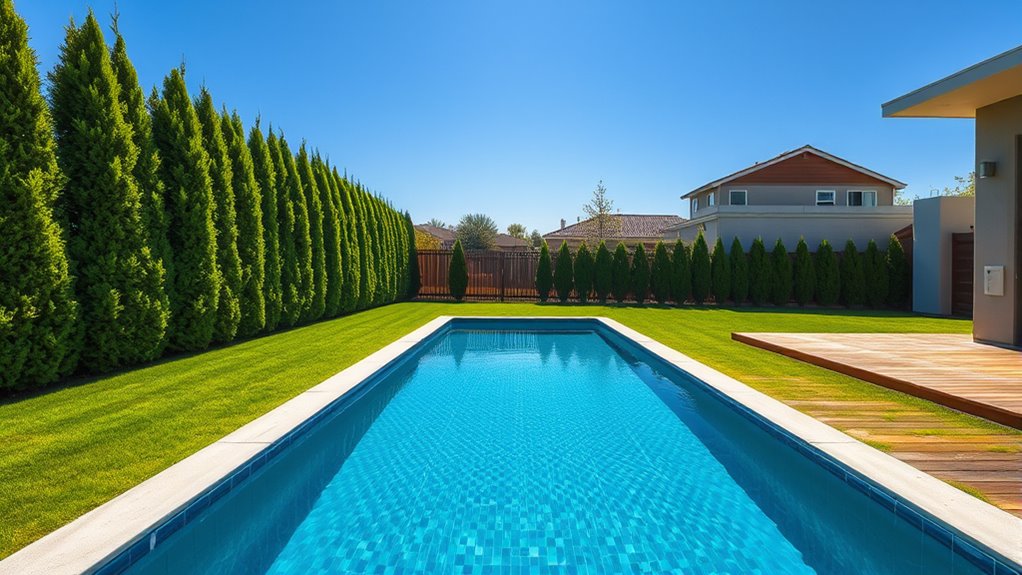
Understanding setback distance requirements and maximum height limits is vital before installing your pool. These regulations can vary greatly depending on your local jurisdiction, so it’s important to verify the specific rules in your area. Being aware of these restrictions helps guarantee your pool project complies with local codes. Additionally, consulting with local authorities or a professional can help ensure you meet all regulatory requirements.
Setback Distance Requirements
Have you ever wondered how close your pool can be to property lines or neighboring structures? Setback distance requirements determine the minimum space you must keep between your pool and property boundaries. These rules prevent disputes, ensure safety, and maintain neighborhood aesthetics. Typically, setback distances vary by local zoning laws, but common standards include:
- A minimum of 5 to 10 feet from side property lines
- At least 10 to 15 feet from rear property lines
- No less than 10 feet from any neighboring structures
- Regulations for front yard setbacks may be less restrictive or non-existent
- Zoning regulations can differ significantly based on your location, so always verify local standards before planning your project.
Always check with your local zoning office, as these distances can differ markedly based on your location. Complying ensures smooth approval and avoids potential legal issues.
Maximum Pool Height Limits
While setback distances guarantee your pool doesn’t encroach on property lines, maximum height limits keep structures within safe and aesthetic boundaries. These limits prevent pools from becoming eyesores or safety hazards by restricting how tall your pool can be. Typically, local zoning laws specify a maximum height—often around four feet—though some areas allow higher structures for features like waterfalls or slides. Meeting these limits ensures your pool blends with neighborhood standards and avoids potential violations. Keep in mind that exceeding height restrictions can lead to fines or the need to modify your design. Always verify your local regulations before planning your pool’s height to ensure compliance. Staying within height limits helps you enjoy your pool safely, without risking legal trouble or neighborhood disputes. Kia Tuning
Variations by Local Jurisdiction
Because local jurisdictions can vary considerably, it’s essential to verify the specific setback and height restrictions in your area before designing your pool. These regulations influence how close your pool can be to property lines and the maximum allowable height of any fencing or structures. Understanding local rules helps prevent costly redesigns or permit delays. Typically, jurisdictions differ in the following ways:
- Minimum setback distances from property boundaries
- Allowed maximum height for pool fences and enclosures
- Variations based on zoning districts (residential, commercial, rural)
- Special provisions for corner lots or properties near streets
- Many jurisdictions also consider building codes and safety standards when establishing pool-related restrictions.
Consult your local planning office or zoning department early to ensure your design complies with all requirements, saving you time and hassle during the permitting process.
Pool Size and Location Restrictions

Are you aware of the specific size and location restrictions that apply to pools in your area? These rules dictate how large your pool can be and where you can place it on your property. Local zoning laws often set maximum pool dimensions based on lot size, ensuring pools don’t overwhelm neighborhoods. They may also specify setback distances from property lines, structures, or easements, which can limit how close your pool can be to boundaries. Some regulations restrict pools in front yards or require certain safety features in specific locations. Before starting your project, review your local codes to confirm your pool’s size and placement comply. Ignoring these restrictions could lead to fines, delays, or the need to modify your plans.
Special Considerations for Community or HOA Rules
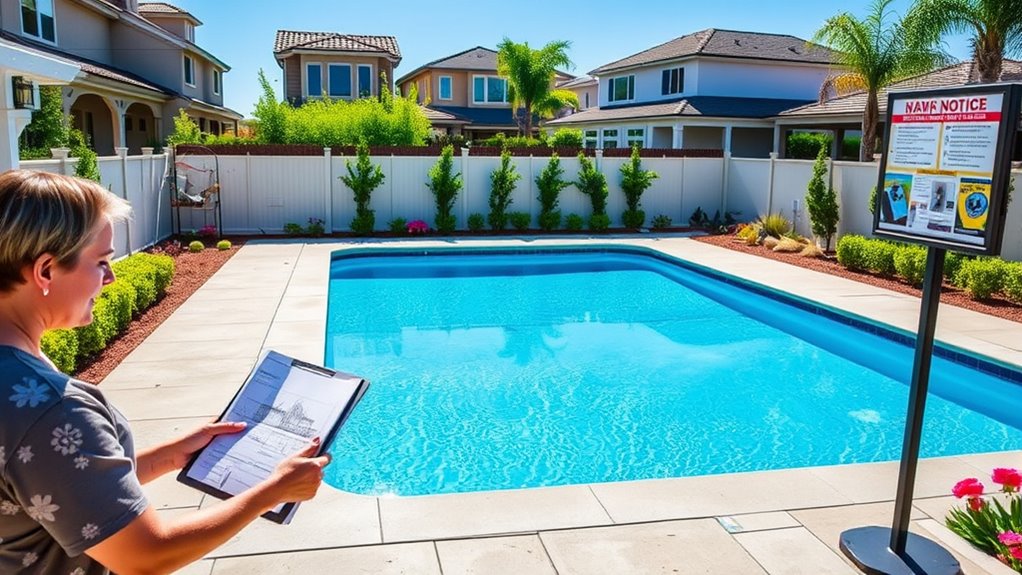
Community and HOA rules can substantially impact your pool project, so it’s essential to review them early in the planning process. These regulations often include specific restrictions that can influence your design, location, or even approval timelines. To navigate this effectively, consider these key points:
- Fencing and Barrier Requirements: Many HOAs mandate specific fencing types or heights for safety and aesthetic consistency.
- Architectural Guidelines: Some communities require pool designs to match existing styles or materials.
- Noise and Privacy Restrictions: Limitations on pool hours or noise levels may affect your usage plans.
- Approval Processes: Be prepared for additional review steps or community meetings before gaining approval.
- AI security measures can also be useful in managing community compliance by monitoring adherence to rules and detecting violations proactively.
Understanding these considerations early guarantees your project proceeds smoothly and stays compliant.
The Application Process for Pool Permits

Guiding the pool permit application process can seem intimidating, but understanding the steps involved makes it much easier. First, check your local zoning and building codes to gather all necessary requirements. You’ll likely need to complete an application form, which includes details about your property and the pool design. Prepare detailed plans and possibly site diagrams, showing setbacks, fencing, and safety features. Submit your application along with any required fees to the appropriate local agency, often the building department. They may review your plans for compliance and request additional information. Once approved, you’ll receive your permit, allowing you to proceed with construction. Keep in mind, processing times vary, so start early to avoid delays.
Common Challenges and How to Overcome Them
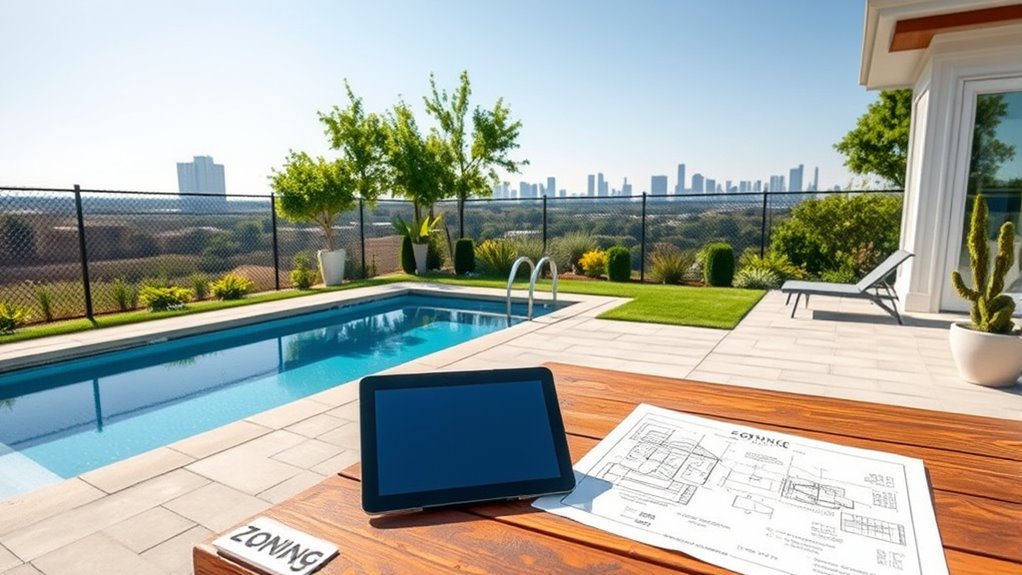
While completing your pool permit application is a significant step, several common challenges can arise during the process. First, navigating complex zoning regulations can be confusing, leading to delays. Second, incomplete or inaccurate documentation often results in rejection or additional requests for information. Third, certain setbacks or height restrictions might limit your pool’s location, requiring adjustments. Fourth, community objections or HOA restrictions can complicate approval. To overcome these challenges:
- Research local zoning laws thoroughly before applying.
- Double-check all documents for accuracy and completeness.
- Consult with a professional to ensure your plans meet setback and height requirements.
- Engage your community early to address concerns proactively.
Addressing these issues head-on streamlines your path to approval and keeps your project on track.
Tips for Ensuring Compliance and Smooth Approval
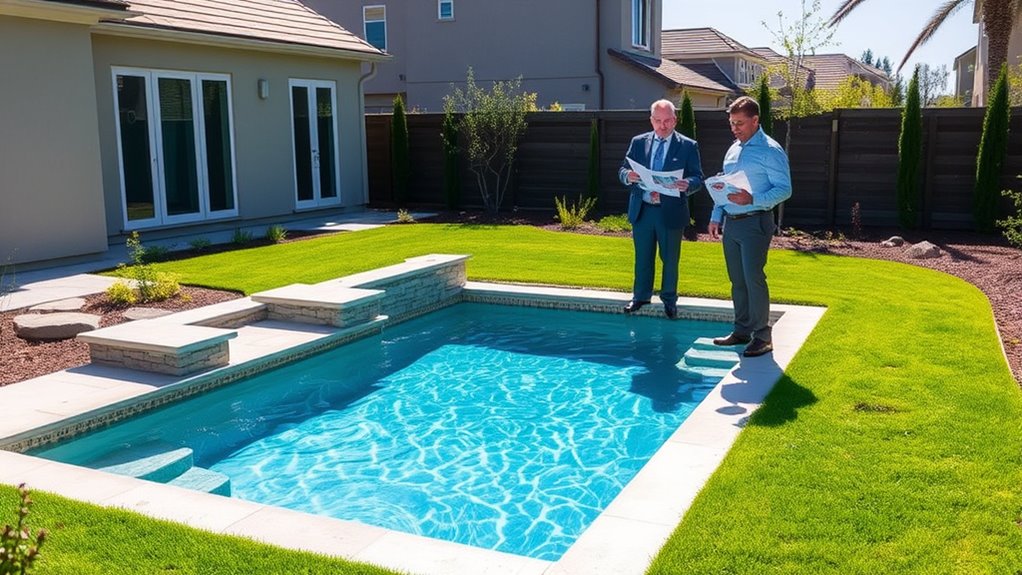
To guarantee your pool permit application proceeds smoothly, you need to focus on adherence from the start. Begin by thoroughly researching local zoning laws and building codes specific to your area. Ensure your plans meet setback requirements, height restrictions, and safety standards. Prepare detailed, accurate documentation, including site plans and engineering drawings, to demonstrate compliance. Consult with local authorities or a professional familiar with zoning regulations early in the process to avoid surprises. Maintain open communication with the permitting office, promptly respond to any requests for additional information, and address issues quickly. Staying organized and proactive minimizes delays and increases your chances of approval. By prioritizing compliance and clear communication, you’ll streamline your permit process and move closer to enjoying your new pool.
Frequently Asked Questions
How Long Does the Permit Approval Process Typically Take?
The permit approval process usually takes about 2 to 4 weeks, but it can vary based on your local regulations and the complexity of your project. You should submit all required documents promptly and follow up regularly. If your application is complete and straightforward, you might see faster approval, whereas more complex projects or extra reviews could extend the timeline. Planning ahead helps guarantee a smoother process.
Are There Specific Safety Requirements for Pool Fencing?
Are you aware of the safety standards for your pool fencing? You need to guarantee your fencing is at least four feet high, non-climbable, and completely encloses the pool area, with self-closing and self-latching gates. These requirements aren’t just rules—they’re essential for protecting loved ones, especially children. Following these guidelines helps prevent accidents and keeps your pool area safe and compliant with local laws.
Can I Build a Pool Without a Permit in My Area?
You probably can’t build a pool without a permit in your area. Most local regulations require permits to guarantee safety and compliance with zoning laws. Skipping this step might lead to fines, delays, or having to remove your pool later. To avoid trouble, check with your city or county’s building department before starting construction. It’s a simple way to ensure your project follows all legal requirements and keeps you safe.
What Are the Consequences of Non-Compliance With Zoning Laws?
Ignoring zoning laws can lead to hefty fines, forced pool removal, and costly legal battles. You might think it’s easier to skip permits, but authorities won’t share your sense of adventure. Non-compliance risks your entire project, turning your backyard oasis into a legal headache. So, while bending rules might seem tempting, following zoning laws guarantees your pool stays a relaxing retreat, not a costly mistake.
Do Zoning Rules Differ for Above-Ground Versus In-Ground Pools?
Yes, zoning rules often differ for above-ground and in-ground pools. Above-ground pools typically face fewer restrictions, but you still need to verify local height and setback requirements. In-ground pools usually require more permits, larger setbacks, and adherence to stricter zoning codes due to their permanence and impact on property size. Always review your local zoning laws to confirm your pool complies, preventing potential fines or the need to modify your project later.
Conclusion
Finding your way through zoning laws might seem daunting, but staying informed guarantees your pool project runs smoothly. By understanding regulations and securing the necessary permits, you avoid costly delays and compliance issues. Remember, taking the time to research local restrictions demonstrates your commitment to responsible development, which often earns quicker approvals. With preparation and patience, you’ll soon be enjoying your new pool, confident that your project meets all legal requirements without sacrificing your vision or peace of mind.




